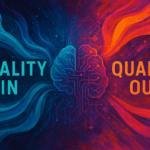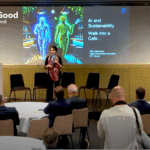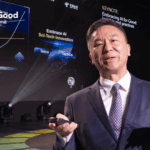Two cars raced around a track in northern France. Both cars had 500 horse-power, 4-wheel drive, and are capable of reaching 282.42 km/h (175.49 mph) – but neither had a driver.
“Roborace is a competition of software,” Lucas Di Grassi, Formula E champion and CEO of Roborace, told ITU.
Currently in its first season – season Alpha – Roborace is a new kind of automotive racing competition.
Teams of developers and engineers develop algorithms for autonomous racing driving. These are then tested on the racetrack using DevBots and Robocars, autonomous, electric vehicles designed and built by Roborace.
“We’re testing and helping each other to develop a base,” said Di Grassi. “The software needs to be further developed but in the future, this will create a lot of opportunities for [the developers] to showcase what they can do.”
The ultimate goal is to use the technology developed on the racetrack to help prevent 1.35 million road deaths every year.
On the road
The technology being developed for the competition will shape an autonomous, driverless future for the road.
“We want to make sure that this new form of autonomous motorsport is relevant for the road,” Bryn Balcombe, Chief Strategy Officer, Roborace and Founder of the Autonomous Drivers Alliance (ADA) told ITU.
“In terms of processing speed, reaction time, high speed, two-way communication … [the technology] will be applied in the commercial vehicles for sure,” said Di Grassi.
Putting this technology on the road is not as simple as it may seem. There are a lot of hurdles to overcome before the widespread deployment of autonomous vehicles, including the behavior of the car on today’s road network.
“If the AI is helping you drive, or if the AI is driving you, the standards for that should be the same. The expectation of performance should be the same,” said Balcombe, who will chair a new ITU Focus Group on ‘AI for autonomous and assisted driving’.
The new ITU Focus Group aims to establish international standards that will monitor and assess the performance of the AI ‘drivers’ that steer automated vehicles – essentially, the equivalent of a driving license for AI drivers.
RELATED: A driving license for autonomous vehicles? Towards a ‘Turing Test’ for AI on our roads
This comes after the concept was born at the 3rd AI for Good Global Summit in May 2019.
New rules of the road
Another hurdle to widespread deployment is the need to update the current regulatory framework for the behavior of human drivers and safe use of cars on the road. Though it has been revised, the Convention on Road Traffic was written in 1968 – a year before humans landed on the moon.
“We need to make sure that the convention is fit for purpose for an AI and robotics era of mobility,” Balcombe told ITU. “That’s really what will lay the framework for 2030 onwards in terms of wide-scale deployment of this technology because it will take about five to seven years to get a new Convention on Road Traffic agreed.”
Given the timeline to agree and approve new road regulations, there is an urgent need update the Convention on Road Traffic text to account for these new self-driving vehicles.
Although there is no specific timeline for the widespread deployment of fully autonomous vehicles on our streets and highways, road tests are already underway in the USA, and Seoul will begin testing autonomous cars in December 2019.
Ahead of the Summer Olympic Games in July in Tokyo, autonomous vehicles will drive freely around the competition venues. Japan aims for the first fully autonomous vehicles to go on sale in 2025.
Worldwide deployment
But key to reducing the number of fatalities on the road is getting the technology where it needs to be. The risk of road traffic death (from human-operated vehicles) is over three times higher in low-income countries than in high-income countries.
Like the proliferation of mobile and computer operating systems, deploying autonomous vehicle safety software worldwide is fairly easy, but the cost remains high.
“The interesting thing with software is that it theoretically becomes quite easy to move if you look at the way operating systems have proliferated. At the moment, there’s a significant cost in the R&D and developing the software in the first place. There’s also a significant cost in the hardware to actually do the sensing and the computing – that’s what makes it cost prohibitive at the moment,” Balcombe told ITU. “So being able to find a way to scale down the cost as you scale up the deployment is going to be really critical.”
Reported and written by Lucy Spencer for ITU News.
Learn more about ITU’s new Focus group ‘AI for autonomous and assisted driving’ here.














